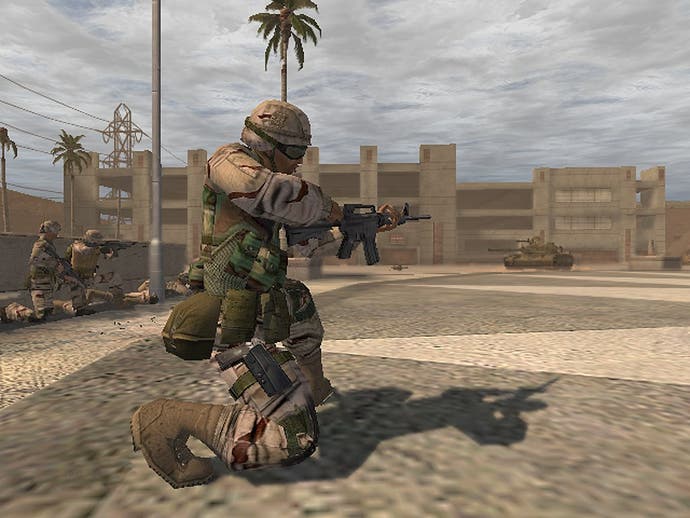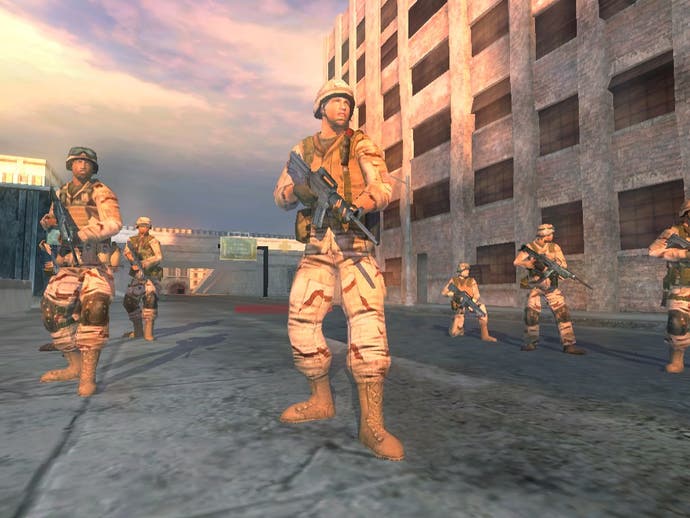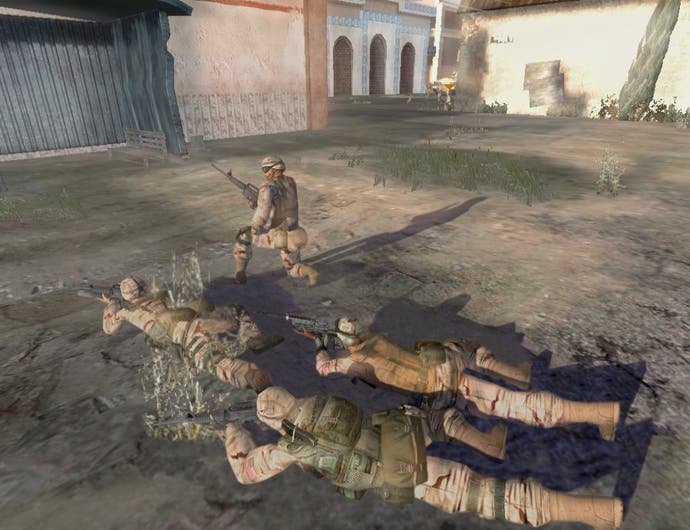Full Spectrum Warrior
For once, a PC version worth talking about: hoo-ah!
Order yours now from Simply Games.
Most console to PC conversions are about as interesting as Pete Waterman's thoughts on Steam Locomotives, which is probably why we rarely bother to cover such things. But in the case of Full Spectrum Warrior, it looks very much like a case of a game that was designed with the PC in mind, rather than just hastily ported when the publisher realised it was worth some extra dollars. For the discerning gamer, this version is easily the best way to experience Pandemic's squad-based urban warfare simulator, with a superior control system, better visuals and two extra missions all adding up deliver one of the most satisfying gaming experiences this year.
If for whatever reason you chose to ignore the Xbox version, released to much acclaim a few months back, here's the drill: you act as team leader to Alpha and Bravo squads - two four-man US Army units on a tour of duty in terrorist-ravaged Zekistan. With each comprised of a team leader, rifleman, grenadier and heavy gunner, you have to mobilise both squads and take out the tangos in a series of tough and dangerous urban warfare situations. But unlike the many other squad-based wargames out there, you don't have direct control over your men; this isn't another Rainbow Six or Hidden & Dangerous, and is all the better because of it.
There's only one colour in the Army and that's green... uh brown

While other games struggle with AI positioning to a greater (H&D) or lesser (R6) extent, in FSW it's all about the placement of your men. Like an elaborate game of war chess, every move has to be plotted with great thought and precision and entirely depends on your ability to place your men sensibly by outflanking enemy and keeping your squads protected and under cover at all times. Any reckless positioning soon results in the enemy AI seeking you out, followed by a slow motion death in black and white and a swift return to your last checkpoint.
To make things simpler, each move you make controls the squad as a whole, and for the whole game you'll hit the right mouse button to begin positioning four blob cursors along the ground in whatever formation you deem to be the most appropriate, and your men will respond accordingly once confirmed with a left mouse button click, darting from point to point with an over-the-shoulder camera giving you the viewpoint of the currently selected soldier. WASD selects which soldier you require, and the camera viewpoint will shift accordingly, and from there you can order your men to perform a series of basic attack commands. The most obvious is to get them to shoot in a specific direction - at an enemy behind cover, for example, if you click and hold the left mouse button and move it in their direction. Aside from that, you can lob a frag grenade at them (once you've positioned the trajectory arc), provide temporary cover with a smoke grenade, pop a slightly more devastating MP203 grenade at them, or in the case of tanks and so on call in an airstrike.
As a control system it lends itself perfectly to the PC, with camera controls in particular far slicker and movement positioning a much more precise and easy to manipulate system than it ever was on the confines of an Xbox control pad. As a result, the game is just that little bit less frustrating, and although provides quite a stern challenge at times never really becomes the sort of game you're cursing because of some glitch in the AI or because of any problem with the interface. Although bad moves can often take way too long to rectify, and your men sometimes seem to take an age to seek out cover points when you've left them high and dry, but ultimately it's down to you. You might curse your own stupidity on several occasions, but for once you can't level the blame at the game designers.
Let's give it a good score... Hoo-ah!

One of the most pleasing aspects about Pandemic's shooter is that the campaign develops as a coherent whole, and although it's effectively split into 12 'episodes' (with two all-new Epilogue levels stitched onto the end - although they're available from the beginning for anybody crossing over from Xbox who wants to get going straight away) you're constantly moving from place to place in a way that starts to mean something, as opposed to the disparate challenges that games like Conflict: Desert Storm and other squad games tend to throw at you.
Although the banter between men gets a bit 'colourful' at times, with expletives aplenty, it's good to note that the family-friendly THQ hasn't chosen to dilute what is, after all, a pretty good approximation of the kind of smack talk that you'd expect from your average US Military throng. AI chatter varies between the desperate pleas of an under-fire unit to the 'hoo-ah!' bravado of another successful kill, and all points in between, even down to the inappropriate musings of their woman getting out of the shower, to dreaming of kicking back with their buds (and Buds) when they get home. It's very American, it's very gung-ho, but never to the extent that it's distasteful or unbelievable. If anything, it adds enormously to what could have otherwise been a very dry tactical simulation, and gives you that kind of suspension of disbelief that we crave with this type of game, but is usually shattered by shoddy AI and daft pathfinding routines.
FSW does cheat a little, allowing your squad mates to walk through one another when changing position - for example when lined up along a wall - and sometimes your squad takes a bizarrely long time to react to an enemy in clear sight. Likewise, the game is often tough on the player as regards what is and isn't under cover. Enemies often look perfectly targetable, yet frustratingly resist all gunfire as well as being impervious to grenades. On the subject of enemy behaviour, it seems the game operates far too rigidly in their placement, basically operating on the basis that they're not going to move from their cover no matter how much gunfire's coming their way.
At Odds

On top of that, it seems odd that the Zekistan rebels aren't more organised themselves, choosing to fight two groups of four US soldiers in clusters of ones and twos. You can see the potential for some quite elaborate battles in FSW, but in a sense the game feels like you're in tutorial mode almost all the way through. You just want to get to the point where there are massed ranks to fight against but it never happens - it's just a polite shootout with an odd enemy here and another one over there. There's never the sense that there's a real war going on; if its intention was to purely represent small scale urban skirmishes then it did its job, but to limit its ambitions to that alone feels slightly unambitious with so much potential there to do so much more.
And, as pointed out in our Xbox review back in July, the game takes place entirely outdoors on a flat plain. In the daytime. Where are the indoor skirmishes or ones where terrain, undulation, weather and lighting conditions play a part? Enemies take delight in occupying sniper positions, yet Pandemic never thought to allow the player to take up the same role at any point, and never even makes clearing buildings part of the experience. No doubt this is a deliberate design decision, but the more you think of the possibilities, the more you realise how varied, expansive and immersive the game could be once the inevitable sequel appears.
The possibilities are quite compelling. It seems feasible that with such a new and unique control and gameplay mechanic in its possession, Pandemic wanted to keep things simple to begin with to introduce the concept and ramp up with all the other features, weapons and so on later on, and up to a point it works a treat. But towards the end of the campaign you do somewhat feel like you're going through the motions, the novelty does wear off a little and the formulaic approach to level design starts showing through.
You know when you've been Tangoed

There is, of course, the online co-op side of the game to explore, which assigns two players a four-man squad each, but to be fair a large part of the game's appeal is being fully in control. Taking that away from the player leaves you to a large extent relying on other people's strategic grasp of proceedings, which might prove entertaining for a while, but just as likely to be a source of frustration as you look on at the hapless attempts of your buddies.
It's arguable whether a competitive multiplayer mode would work, but given that it's more or less a standard feature of action games these days you're left wondering why Pandemic didn't at least give it a go; certainly from the point of view of selling the PC version it would have been a popular inclusion, especially with several teams all duking it out on the same map.
On the technical side of the game, FSW holds up very well on its transition to PC. It's evidently not the most demanding game out there, but delivers very detailed, well animated character models, set in some often beautifully designed environments that for the purposes of the game are superb playgrounds of warfare. Although there are elements, such as destructibility, that could have been dramatically improved and played a greater part in the game as a whole, the whole package is more than acceptable but no doubt held back somewhat by the Xbox. There will be few complaints, at any rate, and whacked up to the highest settings it does the job rather well.
Spectrum +2 (See what we did?)
Still, nitpicky design and technical limitations aside, the 12 hours or so that you'll be playing the single-player game are almost always enjoyable, challenging, and entertaining. It's fair to note the game's limitations, and that allowing the player to do more with their squad rather than merely move them in groups of four might open up the tactical side of the game (as you can with basically any other squad-based shooter ever made), but so long as you enjoy FSW for what it is rather than what it isn't or what it could have been, you'll sit back and admire one of the most refreshingly original approaches to war-gaming there has been since the squad-based sub-genre first crawled out of the bunker six years ago.
Order yours now from Simply Games.








